springer contact mechanics and friction mar 2010 ebook
Bạn đang xem bản rút gọn của tài liệu. Xem và tải ngay bản đầy đủ của tài liệu tại đây (13.97 MB, 367 trang )
Contact Mechanics and Friction
Valentin L. Popov
Contact Mechanics
and Friction
Physical Principles and Applications
1 3
ISBN 978-3-642-10802-0 e-ISBN 978-3-642-10803-7
DOI 10.1007/978-3-642-10803-7
Springer Heidelberg Dordrecht London New York
Library of Congress Control Number: 2010921669
c
Springer-Verlag Berlin Heidelberg 2010
This work is subject to copyright. All rights are reserved, whether the whole or part of the material is
concerned, specifically the rights of translation, reprinting, reuse of illustrations, recitation, broadcasting,
reproduction on microfilm or in any other way, and storage in data banks. Duplication of this publication
or parts thereof is permitted only under the provisions of the German Copyright Law of September 9,
1965, in its current version, and permission for use must always be obtained from Springer. Violations
are liable to prosecution under the German Copyright Law.
The use of general descriptive names, registered names, trademarks, etc. in this publication does not
imply, even in the absence of a specific statement, that such names are exempt from the relevant protective
laws and regulations and therefore free for general use.
Cover design: WMXDesign GmbH
Printed on acid-free paper
Springer is part of Springer Science+Business Media (www.springer.com)
Professor Dr. Valentin L. Popov
10623 Berlin
Germany
Berlin University of Technology
Institute of Mechanics
Strasse des 17.Juni 135
Dr. Valentin L. Popov
studied physics and obtained his doctorate from the Moscow State Lomonosow
University. He worked at the Institute of Strength Physics and Materials Science
of the Russian Academy of Sciences. After a guest-professorship in the field of
theoretical physics at the University of Paderborn, he has headed the department
of System Dynamics and Friction Physics in the Institute of Mechanics at the Ber-
lin University of Technology since 2002. His areas of interest, among others, in-
clude tribology, nanotribology, tribology at low temperatures, biotribology, the in-
fluence of friction through ultrasound, numerical simulation of frictional
processes, research regarding earthquakes, as well as themes relating to materials
sciences such as the mechanics of elastoplastic media with microstructure,
strength of metals and alloys, and shape memory alloys. He is the joint editor of
international journals and regularly organizes international conferences and work-
shops over diverse tribological themes.
Preface to the English Edition
The English edition of “Contact Mechanics and Friction” lying before you is, for
the most part, the text of the 1
st
German edition (Springer Publishing, 2009). The
book was expanded by the addition of a chapter on frictional problems in earth-
quake research. Additionally, Chapter 15 was supplemented by a section on
elasto-hydrodynamics. The problem sections of several chapters were enriched by
the addition of new examples.
This book would not have been possible without the active support of J. Gray,
who translated it from the German edition. I would like to thank Prof. G. G. Ko-
charyan and Prof. S. Sobolev for discussions and critical comments on the chapter
over earthquake dynamics. Dr. R. Heise made significant contributions to the de-
velopment and correction of new problems. I would like to convey my affection-
ate thanks to Dr. J. Starcevic for her complete support during the composition of
this book. I want to thank Ms. Ch. Koll for her patience in creating figures and Dr.
R. Heise, M. Popov, M. Heß, S. Kürscher, and B. Grzemba for their help in proof-
reading.
Berlin, November 2009 V.L. Popov
Preface to the German Edition
He who wishes to better understand the subject of Contact Mechanics and the
Physics of Friction would quickly discover that there is almost no other field that
is so interdisciplinary, exciting, and fascinating. It combines knowledge from
fields such as the theories of elasticity and plasticity, viscoelasticity, materials sci-
ence, fluid mechanics (including both Newtonian and non-Newtonian fluids),
thermodynamics, electrodynamics, system dynamics, and many others. Contact
Mechanics and the Physics of Friction have numerous applications ranging from
measurement and system technologies on a nanoscale to the understanding of
earthquakes and including the sheer overwhelming subject of industrial tribology.
One who has studied and understands Contact Mechanics and the Physics of Fric-
tion will have acquired a complete overview of the different methods that are used
in the engineering sciences.
One goal of this book is to collect and clearly present, in one work, the most
important aspects of this subject and how they relate to each other. Included in
these aspects is, first, the entirety of traditional Contact Mechanics including ad-
hesion and capillarity, then the theory of friction on a macro scale, lubrication, the
foundations of modern nanotribology, system dynamical aspects of machines with
friction (friction induced vibrations), friction related to elastomers, and wear. The
interplay between these aspects can be very complicated in particular cases. In
practical problems, different aspects are always presented in new ways. There is
no simple recipe to solve tribological problems. The only universal recipe is that
one must first understand the system from a tribological point of view. A goal of
this book is to convey this understanding.
It is the solid belief of the author that the essential aspects of mechanical con-
tacts and friction are often much easier than they appear. If one limits oneself to
qualitative estimations, it is then possible to achieve an extensive qualitative un-
derstanding of the countless facets of mechanical contacts and friction. Therefore,
qualitative estimations are highly valued in this book.
In analytical calculations, we limit ourselves to a few classical examples which
we can then take as building blocks and apply them to understand and solve a
wealth of problems with real applications.
A large number of concrete tribological questions, especially if they deal with
meticulous optimization of tribological systems, are not solvable in analytical
form. This book also offers an overview of methods of Numerical Simulation for
Contact Mechanics and Friction. One such method is then explained in detail,
which permits a synthesis of several processes related to contact mechanics from
different spatial ranges within a single model.
Even though this book is primarily a textbook, it can also serve as a reference
for the foundations of this field. Many special cases are presented alongside the
theoretical fundamentals with this goal in mind. These cases are presented as ex-
ercises in their respective chapters. The solutions are provided for every exercise
along with a short explanation and results.
x Preface to the German Edition
The basis of this textbook originates and is drafted from lectures that the author
has conducted over Contact Mechanics and the Physics of Friction at the Berlin
University of Technology, so that the material can be completed in its entirety in
one or two semesters depending on the depth in which it is visited.
Thanks
This book would not have been possible without the active support of my col-
leagues. Several in the department of “System Dynamics and Frictional Physics,”
from the Institute for Mechanics, have contributed to the development of the prac-
tice exercises. For this, I thank Dr. M. Schargott, Dr. T. Geike, Mr. M. Hess, and
Dr. J. Starcevic. I would like to express a heartfelt thanks to Dr. J. Starcevic for
her complete support during the writing of this book as well as to Mr. M. Hess,
who checked all of the equations and corrected the many errors. I thank Ms. Ch.
Koll for her patience constructing figures as well as M. Popov and Dr. G. Putzar
for their help with proofreading. I thank the Dean of Faculty V, Transportation
and Machine Systems, for granting me a research semester, during which this
book was completed.
Berlin, October 2008 V.L. Popov
Table of Contents
1 Introduction 1
1.1 Contact and Friction Phenomena and their Applications 1
1.2 History of Contact Mechanics and the Physics of Friction 3
1.3 Structure of the Book 7
2 Qualitative Treatment of Contact Problems – Normal Contact without
Adhesion 9
2.1 Material Properties 10
2.2 Simple Contact Problems 13
2.3 Estimation Method for Contacts with a Three-Dimensional, Elastic
Continuum 16
Problems 20
3 Qualitative Treatment of Adhesive Contacts 25
3.1 Physical Background 26
3.2 Calculation of the Adhesive Force between Curved Surfaces 30
3.3 Qualitative Estimation of the Adhesive Force between Elastic Bodies 31
3.4 Influence of Roughness on Adhesion 33
3.5 Adhesive Tape 34
3.6 Supplementary Information about van der Waals Forces and Surface
Energies 35
Problems 36
4 Capillary Forces 41
4.1 Surface Tension and Contact Angles 41
4.2 Hysteresis of Contact Angles 45
4.3 Pressure and the Radius of Curvature 45
4.4 Capillary Bridges 46
4.5 Capillary Force between a Rigid Plane and a Rigid Sphere 47
4.6 Liquids on Rough Surfaces 48
4.7 Capillary Forces and Tribology 49
Problems 50
5 Rigorous Treatment of Contact Problems – Hertzian Contact 55
5.1 Deformation of an Elastic Half-Space being Acted upon by Surface
Forces 56
5.2 Hertzian Contact Theory 59
5.3 Contact between Two Elastic Bodies with Curved Surfaces 60
5.4 Contact between a Rigid Cone-Shaped Indenter and an Elastic
Half-Space 63
5.5 Internal Stresses in Hertzian Contacts 64
Problems 67
xii Table of Contents
6 Rigorous Treatment of Contact Problems – Adhesive Contact 71
6.1 JKR-Theory 72
Problems 77
7 Contact between Rough Surfaces 81
7.1 Model from Greenwood and Williamson 82
7.2 Plastic Deformation of Asperities 88
7.3 Electrical Contacts 89
7.4 Thermal Contacts 92
7.5 Mechanical Stiffness of Contacts 93
7.6 Seals 93
7.7 Roughness and Adhesion 94
Problems 95
8 Tangential Contact Problems 105
8.1 Deformation of an Elastic Half-Space being Acted upon
by
Tangential Forces 106
8.2 Deformation of an Elastic Half-Space being Acted upon
by a
Tangential Stress Distribution 107
8.3 Tangential Contact Problems without Slip 109
8.4 Tangential Contact Problems Accounting for Slip 110
8.5 Absence of Slip for a Rigid Cylindrical Indenter 114
Problems 114
9 Rolling Contact 119
9.1 Qualitative Discussion of the Processes in a Rolling Contact 120
9.2 Stress Distribution in a Stationary Rolling Contact 122
Problems 128
10 Coulomb’s Law of Friction 133
10.1 Introduction 133
10.2 Static and Kinetic Friction 134
10.3 Angle of Friction 135
10.4 Dependence of the Coefficient of Friction on the Contact Time 136
10.5 Dependence of the Coefficient of Friction on the Normal Force 137
10.6 Dependence of the Coefficient of Friction on Sliding Speed 139
10.7 Dependence of the Coefficient of Friction on the Surface Roughness 139
10.8 Coulomb’s View on the Origin of the Law of Friction 140
10.9 Theory of Bowden and Tabor 142
10.10 Dependence of the Coefficient of Friction on Temperature 145
Problems 146
11 The Prandtl-Tomlinson Model for Dry Friction 155
11.1 Introduction 155
11.2 Basic Properties of the Prandtl-Tomlinson Model 157
Table of Contents xiii
11.3 Elastic Instability 161
11.4 Superlubricity 165
11.5 Nanomachines: Concepts for Micro and Nano-Actuators 166
Problems 170
12 Frictionally Induced Vibrations 175
12.1 Frictional Instabilities at Decreasing Dependence of the Frictional
Force on the Velocity 176
12.2 Instability in a System with Distributed Elasticity 178
12.3 Critical Damping and Optimal Suppression of Squeal 181
12.4 Active Suppression of Squeal 183
12.5 Strength Aspects during Squeal 185
12.6 Dependence of the Stability Criteria on the Stiffness of the System 186
12.7 Sprag-Slip 191
Problems 193
13 Thermal Effects in Contacts 199
13.1 Introduction 200
13.2 Flash Temperatures in Micro-Contacts 200
13.3 Thermo-Mechanical Instability 202
Problems 203
14 Lubricated Systems 207
14.1 Flow between two parallel plates 208
14.2 Hydrodynamic Lubrication 209
14.3 “Viscous Adhesion” 213
14.4 Rheology of Lubricants 216
14.5 Boundary Layer Lubrication 218
14.6 Elastohydrodynamics 219
14.7 Solid Lubricants 222
Problems 223
15 Viscoelastic Properties of Elastomers 231
15.1 Introduction 231
15.2 Stress-Relaxation 232
15.3 Complex, Frequency-Dependent Shear Moduli 234
15.4 Properties of Complex Moduli 236
15.5 Energy Dissipation in a Viscoelastic Material 237
15.6 Measuring Complex Moduli 238
15.7 Rheological Models 239
15.8 A Simple Rheological Model for Rubber (“Standard Model”) 242
15.9 Influence of Temperature on Rheological Properties 244
15.10 Master Curves 245
15.11 Prony Series 246
Problems 250
xiv Table of Contents
16 Rubber Friction and Contact Mechanics of Rubber 255
16.1 Friction between an Elastomer and a Rigid Rough Surface 255
16.2 Rolling Resistance 261
16.3 Adhesive Contact with Elastomers 263
Problems 265
17 Wear 271
17.1 Introduction 271
17.2 Abrasive Wear 272
17.3 Adhesive Wear 275
17.4 Conditions for Low-Wear Friction 278
17.5 Wear as the Transportation of Material from the Friction Zone 279
17.6 Wear of Elastomers 280
Problems 283
18 Friction Under the Influence of Ultrasonic Vibrations 285
18.1 Influence of Ultrasonic Vibrations on Friction from a Macroscopic
Point of View 286
18.2 Influence of Ultrasonic Vibrations on Friction from a Microscopic
Point of View 291
18.3 Experimental Investigations of the Force of Static Friction as a
Function of the Oscillation Amplitude 293
18.4 Experimental Investigations of Kinetic Friction as a Function of
Oscillation Amplitude 295
Problems 297
19 Numerical Simulation Methods in Friction Physics 301
19.1 Simulation Methods for Contact and Frictional Problems:
An Overview 302
19.1.1 Many-Body Systems 302
19.1.2 Finite Element Methods 303
19.1.3 Boundary Element Method 304
19.1.4 Particle Methods 305
19.2 Reduction of Contact Problems from Three Dimensions to One
Dimension 306
19.3 Contact in a Macroscopic Tribological System 307
19.4 Reduction Method for a Multi-Contact Problem 311
19.5 Dimension Reduction and Viscoelastic Properties 315
19.6 Representation of Stress in the Reduction Model 316
19.7 The Calculation Procedure in the Framework of the Reduction
Method 317
19.8 Adhesion, Lubrication, Cavitation, and Plastic Deformations in the
Framework of the Reduction Method 318
Problems 318
Table of Contents xv
20 Earthquakes and Friction 323
20.1 Introduction 324
20.2 Quantification of Earthquakes 325
20.2.1 Gutenberg-Richter Law 326
20.3 Laws of Friction for Rocks 327
20.4 Stability during Sliding with Rate- and State-Dependent Friction 331
20.5 Nucleation of Earthquakes and Post-Sliding 334
20.7 Continuum Mechanics of Block Media and the Structure of Faults 338
20.8 Is it Possible to Predict Earthquakes? 342
Problems 343
Appendix 347
Further Reading 351
Figure Reference 357
Index 359
20.6 Foreshocks and Aftershocks 337
1 Introduction
1.1 Contact and Friction Phenomena and their Applications
Contact Mechanics and the Physics of Friction are fundamental disciplines of the
engineering sciences, which are indispensable for the construction of safe and en-
ergy-saving designs. They are of interest for countless applications, for example
clutches, brakes, tires, bush and ball bearings, combustion engines, hinges, gas-
kets, castings, machining, cold forming, ultrasonic welding, electrical contacts,
and many others. These applications have tasks spanning from stress analysis of
contact elements and joints, over the influence of lubrication and material design
on friction and wear, to applications in micro and nanotechnology. Friction is a
phenomenon that people have been interested in for over hundreds and even thou-
sands of years and still today remains in the middle of the development of new
products and technologies.
A classical example of contact is a rail-wheel contact, in which we are inter-
ested foremost in material strength and force transmission properties. Contacts can
transfer mechanical force (screws), conduct electricity or heat, or prevent the flow
of material (seals). The contact between the tip of an atomic force microscope and
the underlying material or the contact between two tectonic plates are examples of
frictional contacts as well. Contact and friction phenomena on different scales,
from nanoscale phenomena to those on a mega-scale, have much in common and,
thus, can be approached with similar methods. Contact mechanics and the physics
V.L. Popov, Contact Mechanics and Friction, DOI 10.1007/978-3-642-10803-7_1,
© Springer-Verlag Berlin Heidelberg 2010
2 1 Introduction
of friction has proven to be an enormous field in modern research and technology,
stretching from the movement of motor proteins and muscular contractions to
earthquake dynamics as well as including the enormous field of industrial tribol-
ogy.
Friction leads to energy dissipation and in micro-contacts, where extreme stress
is present, to micro-fractures and surface wear. We often try to minimize friction
during design in an attempt to save energy. There are, however, many situations in
which friction is necessary. Without friction, we cannot enjoy violin music or even
walk or drive. There are countless instances, in which friction should be maxi-
mized instead of minimized, for example between tires and the road during brak-
ing. Also, wear must not always be minimized. Fast and controllable abrasive
techniques can actually form the basis for many technological processes, (e.g.,
grinding, polishing, and sandblasting.)
Friction and wear are very closely connected with the phenomenon of adhe-
sion. For adhesion it is important to know if a close contact can be created be-
tween two bodies. While adhesion does not play a considerable role on a large-
scale in the contact between two “hard bodies” such as metal or wood, in instances
in which one of the bodies in contact is soft, the role of adhesion becomes very
noticeable and can be taken advantage of in many applications. One can also learn
much from contact mechanics for the use of adhesives. In micro-technology, ad-
hesion gains even greater importance. Friction and adhesive forces on a micro-
scale present a real problem and have been termed “sticktion” (sticking and fric-
tion).
Another phenomenon, which is similar to adhesion and will be discussed in this
book, is capillary force, which appears in the presence of low quantities of fluid.
In very precise mechanisms such as clocks, the moisture contained in the air can
cause capillary forces, disturbing the exactness of such mechanisms. Capillary
forces can also be used, however, to control the flow of a lubricant to an area of
friction.
In a book about contact and friction one cannot silently pass over the closely
related sound-phenomena. Brakes, wheel-track contact, and bearings do not only
dissipate energy and material. They often squeak and squeal unpleasantly or even
with such intensity as to be damaging to one’s hearing. Noise caused by technical
systems is a central problem today in many engineering solutions. Friction in-
duced vibrations are closely related to the properties of frictional forces and are
likewise a subject of this book.
If we had to measure the importance of a tribological field in terms of the
amount of money that has been invested in it, lubrication technology would defi-
nitely take first place. Unfortunately, it is not possible to grant lubrication a corre-
spondingly large section in this book. The fundamentals of hydrodynamic and
elasto-hydrodynamic lubrication, however, are of course included.
The subject of contact mechanics and friction is ultimately about our ability to
control friction, adhesion, and wear and to mould them to our wishes. For that, a
detailed understanding of the dependency of contact, friction, and wear phenom-
ena on the materials and system properties is necessary.
1.2 History of Contact Mechanics and the Physics of Friction 3
1.2 History of Contact Mechanics and the Physics of Friction
A first impression of tribological applications and their importance can be con-
veyed by its history. The term “Tribology” was suggested by Peter Jost in May of
1966 as a name for the research and engineering subject which occupies itself with
contact, friction, and wear. Except for the name, tribology itself is ancient. Its be-
ginning is lost in the far reaches of history. The creation of fire through frictional
heating, the discovery of the wheel and simple bushings, and the use of fluids to
reduce frictional forces and wear were all “tribological inventions” that were al-
ready known thousands of years before Christ. In our short overview of the history
of tribology, we will jump to the developments that took place during the Renais-
sance and begin with the contributions of Leonardo da Vinci.
In his Codex-Madrid I (1495), da Vinci describes the ball-bearing, which he
invented, and the composition of a low-friction alloy as well his experimental ex-
amination of friction and wear phenomena. He was the first engineer who persis-
tently and quantitatively formulated the laws of friction. He arrived at the conclu-
sion that can be summarized in today’s language as two fundamental Laws of
Friction:
1. The frictional force is proportional to the normal force, or load.
2. The frictional force is independent of the contact surface area.
Da Vinci was, de facto, the first to introduce the term coefficient of friction and
to experimentally determine its typical value of ¼.
As so often happens in the history of science, these results were forgotten and
around 200 years later, rediscovered by the French physicist Guillaume Amontons
(1699). The proportionality of the frictional force to the normal force is, therefore,
known as “Amontons’ Law.”
Leonard Euler occupied himself with the mathematical point of view of friction
as well as the experimental. He introduced the differentiation between static fric-
tional forces and kinetic frictional forces and solved the problem of rope friction,
probably the first contact problem to be analytically solved in history (1750). He
was the first to lay the foundations of the mathematical way of dealing with the
law of dry friction and in this way promoted further development. We have him to
thank for the symbol
μ
as the coefficient of friction. Euler worked with the idea
that friction originates from the interlocking between small triangular irregularities
and that the frictional coefficient is equal to the gradient of these irregularities.
This understanding survived, in different variations, for a hundred years and is
also used today as the “Tomlinson Model” in connection with friction on an
atomic scale.
An outstanding and still relevant contribution to the examination of dry friction
was achieved by the French engineer Charles Augustin Coulomb. The law of dry
friction deservingly carries his name. Coulomb confirmed Amontons’ results and
established that sliding friction is independent of the sliding speed in a first order
approximation. He undertook a very exact quantitative examination of dry friction
4 1 Introduction
between solid bodies in relation to the pairing of materials, surface composition,
lubrication, sliding speed, resting time for static friction, atmospheric humidity,
and temperature. Only since the appearance of his book “Theory of Simple Ma-
chines,” (1781) could the differentiation between kinetic and static friction be
quantitatively substantiated and established. Coulomb used the same idea of the
origin of friction as Euler, but added another contribution to friction that we would
now call the adhesion contribution. It was likewise Coulomb who established de-
viations from the known simple law of friction. He found out, for example, that
the static force grows with the amount of time the object has remained stationary.
For his examinations, Coulomb was well ahead of his time. His book contained
practically everything that eventually became the original branches of tribology.
Even the name of the measuring instrument, the tribometer, stems from Coulomb.
Examinations of rolling friction have not played as a prominent role in history
as sliding friction, probably because rolling friction is much smaller in magnitude
than sliding friction and, therefore, less annoying. The first ideas of the nature of
rolling friction for rolling on plastically deformable bodies, of which the most im-
portant elements are still considered correct, come from Robert Hooke (1685). A
heated discussion between Morin and Dupuit that took place in 1841-42 over the
form of the law of rolling friction showed that the nature of the friction was very
dependent on the material and loading parameters. According to Morin the rolling
friction should be inversely proportional to the radius of the rolling body, but ac-
cording to Dupuit it should be inversely proportional to the square root of the ra-
dius. From today’s point of view both statements are limitedly correct under dif-
fering conditions.
Osborne Reynolds was the first to experimentally examine the details of the
events happening in the contact area during rolling contact and established that on
a driven wheel, there are always areas in which the two bodies are in no-slip con-
tact and areas where slipping takes place. It was the first attempt to put tribologi-
cal contact underneath a magnifying glass and at the same time the end of the
strict differentiation between static friction and kinetic friction. Reynolds ac-
counted for the energy loss during rolling with the existence of partial sliding. A
quantitative theory could later be achieved by Carter (1926) only after the founda-
tions of contact mechanics were laid by Hertz.
Humans have lubricated mechanical contacts for hundreds of years in order to
decrease friction, but it was rising industrial demands that coerced researchers ex-
perimentally and theoretically to grapple with lubrication. In 1883 N. Petrov per-
formed his experimental examinations of journal bearings and formulated the most
important laws of hydrodynamic lubrication. In 1886 Reynolds published his the-
ory of hydrodynamic lubrication. The “Reynolds Equation,” which he developed,
established the basis for calculations in hydrodynamically lubricated systems. Ac-
cording to the hydrodynamic lubrication theory, the coefficient of friction has an
the order of magnitude of
/hL
μ
≈
, where h is the thickness of the lubricating
film and
L is the length of the tribological contact. This holds true so long as the
surfaces do not come so close to one another that the thickness of the lubrication
1.2 History of Contact Mechanics and the Physics of Friction 5
film becomes comparable to the roughness of the two surfaces. Such a system
would then fall into the realm of mixed friction which was extensively examined
by Stribeck (1902). The dependence of the frictional force on the sliding speed
with a characteristic minimum is named the Stribeck-Curve.
Other conditions can come into play with even greater loads or insufficient lu-
brication in which only a few molecular layers of lubricant remain between the
bodies in contact. The properties of this boundary lubrication were investigated by
Hardy (1919-22). He showed that only molecular layer of grease drastically influ-
enced the frictional forces and wear of the two bodies. Hardy measured the de-
pendence of frictional forces on the molecular weight of the lubricant and the sur-
faces of the metals and also recognized that the lubricant adheres to the metal
surfaces. The decreased friction is owed to the interaction of the polymer-
molecules of the lubricant, which is today sometimes called a “grafted liquid.”
A further advance in our understanding of contact mechanics, as well as dry
friction, in the middle of the twentieth century is bound to two names: Bowden
and Tabor. They were the first to advise the importance of the roughness of the
surfaces of the bodies in contact. Because of this roughness, the real contact area
between the two bodies is typically orders of magnitude smaller than the apparent
contact area. This understanding abruptly changed the direction of many tribologi-
cal examinations and again brought about Coulomb’s old idea of adhesion being a
possible mechanism of friction. In 1949, Bowden and Tabor proposed a concept
which suggested that the origin of sliding friction between clean, metallic surfaces
is explained through the formation and shearing of cold weld junctions. According
to this understanding, the coefficient of friction is approximately equal to the ratio
of critical shear stress to hardness and must be around 1/6 in isotropic, plastic ma-
terials. For many non-lubricated metallic pairings (e.g. steel with steel, steel with
bronze, steel with iron, etc.), the coefficient of friction actually does have a value
on the order of
0.16
μ
∼ .
The works of Bowden and Tabor triggered an entirely new line of theory of
contact mechanics regarding rough surfaces. As pioneering work in this subject
we must mention the works of Archard (1957), who concluded that the contact
area between rough elastic surfaces is approximately proportional to the normal
force. Further important contributions were made by Greenwood and Williamson
(1966), Bush (1975), and Persson (2002). The main result of these examinations is
that the real contact areas of rough surfaces are approximately proportional to the
normal force, while the conditions in individual micro-contacts (pressure, size of
micro-contact) depend only weakly on the normal force.
With the development of the automobile industry, along with increasing speeds
and power, rubber friction has gained a technical importance. The understanding
of the frictional mechanisms of elastomers, and above all, the conclusion that the
friction of elastomers is connected with the dissipation of energy through defor-
mation of the material and consequently with its rheology, a fact that is generally
accepted today, can be owed to the classical works of Grosch (1962).
6 1 Introduction
Contact mechanics definitely forms the foundations for today’s understanding
of frictional phenomena. In history, frictional phenomena were earlier and more
fundamentally examined in comparison to pure contact mechanical aspects. The
development of the railroad was most certainly a catalyst for interest in exact cal-
culations of stress values, because in wheel-rail contact the stresses can reach the
maximum loading capacity for steel.
Classical contact mechanics is associated with Heinrich Hertz above all others.
In 1882, Hertz solved the problem of contact between two elastic bodies with
curved surfaces. This classical result forms a basis for contact mechanics even to-
day. It took almost a century until Johnson, Kendall, and Roberts found a similar
solution for adhesive contact (JKR-Theory). This may come from the general ob-
servation that solid bodies do not adhere to one another. Only after the develop-
ment of micro-technology, did engineers run into the problem of adhesion. Almost
at the same time, Derjagin, Müller, and Toporov developed another theory of ad-
hesive contact. After an initially fervid discussion, Tabor realized that both theo-
ries are correct limiting cases for the general problem.
It is astonishing that wear phenomena, despite their overt significance, were
studied seemingly late. The reason for this delay may lie in the fact that the lead-
ing cause of wear is through the interactions of micro-contacts, which became an
object of tribological research only after the work of Bowden and Tabor. The law
of abrasive wear, which states that wear is proportional to load and sliding dis-
tance and inversely proportional to hardness of softer contact partners, was dis-
covered by M. Kruschov (1956) through experimental examination and later also
confirmed by Archard (1966). The examinations of the law of adhesive wear, as
with abrasive wear, are tied to Tabor and Rabinowicz. Despite these studies, wear
mechanisms, especially under conditions in which very little wear takes place, are
still today some of the least understood tribological phenomena.
Since the last decade of the twentieth century, contact mechanics has experi-
enced a rebirth. The development of experimental methods for investigating fric-
tional processes on the atomic scale (atomic force microscope, friction force mi-
croscope, quartz-crystal microbalance, surface force apparatus) and numerical
simulation methods have provoked a sudden growth during these years in the
number of research activities in the field of friction between solid bodies. Also,
the development of micro-technology essentially accounts for the largest pursuit in
contact mechanics and the physics of friction. Experimentalists were offered the
ability to examine well defined systems with stringently controlled conditions, for
instance, the ability to control the thickness of a layer of lubrication or the relative
displacement between two fixed surfaces with a resolution on the atomic level.
There is, however, a gap between classical tribology and nanotribology that has
yet to be closed.
1.3 Structure of the Book 7
1.3 Structure of the Book
Contact and friction always go hand in hand and are interlaced in many ways in
real systems. In our theoretical treatment, we must first separate them. We begin
our investigation of contact and frictional phenomena with contact mechanics.
This, in turn, begins with a qualitative analysis, which provides us with a simple,
but comprehensive understanding of the respective phenomena. Afterwards, we
will delve into the rigorous treatment of contact problems and subsequently move
on to frictional phenomena, lubrication, and wear.
2 Qualitative Treatment of Contact Problems –
Normal Contact without Adhesion
We begin our consideration of contact problems with the normal contact problem.
A normal contact problem revolves around two bodies which are brought into con-
tact with one another by forces perpendicular to their surfaces. A prominent ex-
ample is the wheel of a train on a rail. The two most important relationships that
the theory of normal contact should deliver are:
(1) The relationship between the contact force and the normal displacement
of the body, which determines the stiffness of the contact and therefore
the dynamic properties of the system.
(2) The relationships between forces and contact stresses and whether or not
they exceed the critical values.
Without actual geometric contact there can be no other contact phenomena, no
friction, and no wear. In this sense, one can regard normal contact as a basic pre-
requisite for all tribological phenomena. It must also be noted that, in general, with
normal contact there will still be relative motion in the tangential direction, be-
cause of the differences in the transverse contraction of the bodies in contact.
Thereby, frictional forces in the surface layers come into play. If we consider that
frictional forces are essentially due to the contact between micro-asperities of the
surface, we see that the normal and tangential loadings and friction are entangled
in even the simplest of contact problems. In a first order approximation, we would
like to distance ourselves from these complications and investigate the pure nor-
mal contact problem, in which we assume that there are no frictional forces pre-
V.L. Popov, Contact Mechanics and Friction, DOI 10.1007/978-3-642-10803-7_2,
© Springer-Verlag Berlin Heidelberg 2010
10 2 Qualitative Treatment of Contact Problems – Normal Contact without Adhesion
sent in the contact area. Also, the always present attractive force, adhesion, will be
neglected for the time being.
An analytical or numerical analysis of contact problems is even in the simplest
of cases very complicated. A qualitative understanding of contact problems, on the
other hand, is obtainable with very simple resources. Therefore, we begin our dis-
cussion with methods of qualitative analysis of contact phenomena, which can
also be used in many cases for dependable, quantitative estimations. A rigorous
treatment of the most important classical contact problems continues in the fol-
lowing chapters. We will investigate a series of contact problems between bodies
of different forms, which can often be used as building blocks for more compli-
cated contact problems.
2.1 Material Properties
This book assumes that the reader is acquainted with the fundamentals of elasticity
theory. In this chapter, we will summarize only definitions from the most impor-
tant material parameters that have bearing on the qualitative investigation of con-
tact mechanical questions. This summary does not replace the general definitions
and equations of elasticity theory and plasticity theory.
(a) Elastic Properties. In a uniaxial tensile test, a slender beam with a constant
cross-sectional area
A
and an initial length
0
l is stretched by
Δ
l . The ratio of the
tensile force to the cross-sectional area is the tensile stress
σ
=
F
A
. (2.1)
The ratio of the change in length to the initial length is the tensile strain or defor-
mation:
0
ε
Δ
=
l
l
. (2.2)
A typical stress-strain diagram for many metals and non-metals is presented in
Fig. 2.1. For small stresses, the stress is proportional to the deformation
σ
ε
= E . (2.3)
The proportionality coefficient
E is the modulus of elasticity of the material. The
elongation is related to the cross-sectional contraction, which is characterized by
Poisson’s Ratio (or transverse contraction coefficient)
ν
. An incompressible ma-
terial has a Poisson’s ratio of 1/2
ν
=
.
Similarly, the shear modulus is defined as the proportionality coefficient be-
tween the shear stress and the resulting shear deformation. The shear modulus is
related to the elasticity coefficient and Poisson’s ratio according to
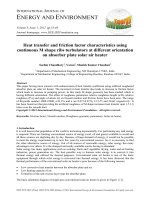
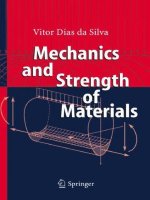
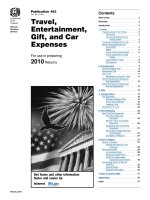
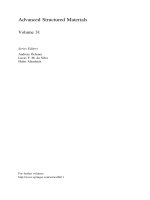
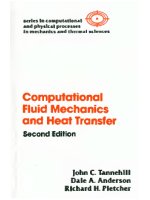
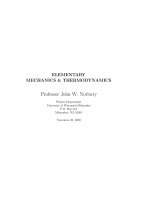
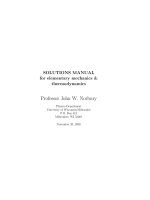
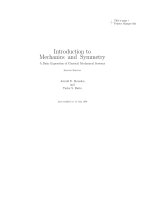
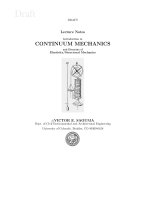
![Matrix quantum mechanics and 2 d string theory [thesis] s alexandrov](https://media.store123doc.com/images/document/14/rc/ya/medium_8kAdgQLKd0.jpg)